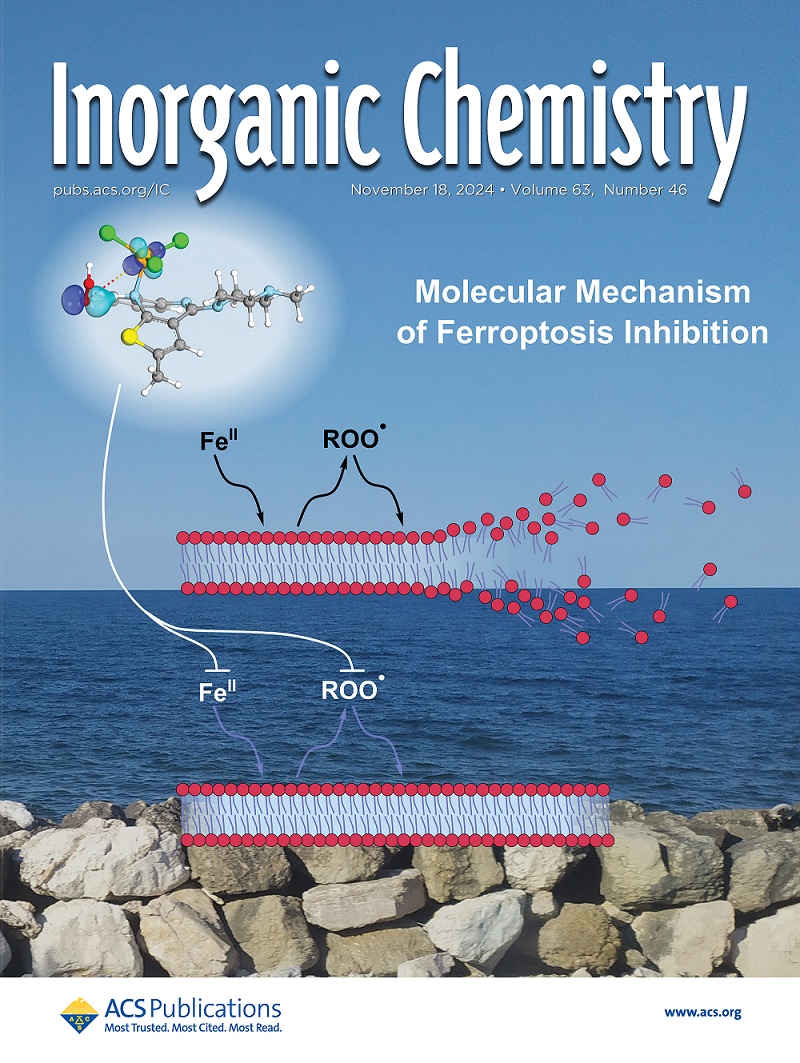有机-无机卤化锰杂化物的双开关介电和光致发光响应。
IF 4.3
2区 化学
Q1 CHEMISTRY, INORGANIC & NUCLEAR
引用次数: 0
摘要
多功能响应材料在传感器和光电子器件中具有潜在的应用前景;然而,成功地瞄准这些材料仍然是一个重大挑战。在本研究中,我们合成了两个零维杂化体:(C6H16N)2MnBr1.53Cl2.47 (1, C6H16N =三甲基丙基铵)和(C7H18N)2MnBr1.40Cl2.60 (2, C7H18N =三甲基丁基铵)。这些化合物是由假球状有机铵阳离子与高发射的[MnX4]2- (X = Br或Cl)阴离子结合而成的。这两种化合物都经历了有序无序的结构相变,表现出热滞后:在331 K(加热)/326 K(冷却)时为1,在383 K/373 K和445 K/428 K(加热/冷却)时分别为2。这些转变导致可切换的介电行为。在环境条件下,两种化合物都能发出[MnX4]2-阴离子的明亮特征发光,1的光致发光量子产率(PLQY)为88.71%,2的为94.59%。然而,它们在高温下表现出热猝灭(1为~ 420 K, 2为~ 460 K)。在它们的相变温度附近,这两种化合物也显示出可切换的发光特性。总的来说,1和2代表了具有双开关介电和发光响应的材料的罕见例子。本文章由计算机程序翻译,如有差异,请以英文原文为准。
Dual-Switchable Dielectric and Photoluminescence Response in Organic-Inorganic Manganese Halide Hybrids.
Multifunctional response materials exhibit potential applications in sensors and optoelectronic devices; however, successfully targeting such materials remains a significant challenge. In this study, we synthesized two zero-dimensional hybrids: (C6H16N)2MnBr1.53Cl2.47 (1, C6H16N = trimethyl propyl ammonium) and (C7H18N)2MnBr1.40Cl2.60 (2, C7H18N = trimethyl butyl ammonium). These compounds were formed by combining pseudoglobular organic ammonium cations with the highly emissive [MnX4]2- (X = Br or Cl) anion. Both compounds undergo order-disorder structural phase transitions, exhibiting thermal hysteresis: 1 at 331 K (heating)/326 K (cooling) and 2 at 383 K/373 K and 445 K/428 K (heating/cooling), respectively. These transitions result in a switchable dielectric behavior. At ambient conditions, both compounds emit the bright characteristic luminescence of the [MnX4]2- anion, with photoluminescence quantum yields (PLQY) of 88.71% for 1 and 94.59% for 2. However, they exhibit thermal quenching at elevated temperatures (∼420 K for 1 and ∼460 K for 2). Near their phase transition temperatures, both compounds also show switchable luminescent properties. Collectively, 1 and 2 represent rare examples of materials exhibiting dual-switchable dielectric and luminescence responses.
求助全文
通过发布文献求助,成功后即可免费获取论文全文。
去求助
来源期刊

Inorganic Chemistry
化学-无机化学与核化学
CiteScore
7.60
自引率
13.00%
发文量
1960
审稿时长
1.9 months
期刊介绍:
Inorganic Chemistry publishes fundamental studies in all phases of inorganic chemistry. Coverage includes experimental and theoretical reports on quantitative studies of structure and thermodynamics, kinetics, mechanisms of inorganic reactions, bioinorganic chemistry, and relevant aspects of organometallic chemistry, solid-state phenomena, and chemical bonding theory. Emphasis is placed on the synthesis, structure, thermodynamics, reactivity, spectroscopy, and bonding properties of significant new and known compounds.
 求助内容:
求助内容: 应助结果提醒方式:
应助结果提醒方式:


